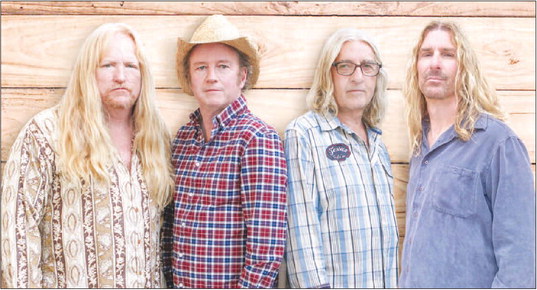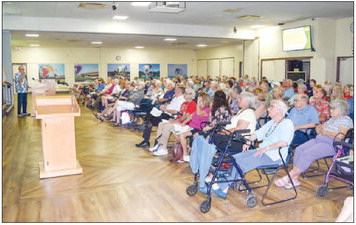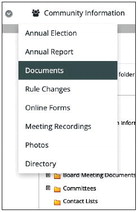COVID-19


‘
Be careful. It's no joke.
Sandy Geffner: His Story and a Message
Sandy Geffner of Mutual 3 is a LW fixture. He’s someone with a quick smile and a helping hand. For a dozen years, he’s made a lot of friends on stage, in clubs and in volunteer service to LWers. He was treasurer for the Golden Age Foundation for two-and-a-half years. He’s served on his Mutual board as CFO for three years and is now a GRF director, volunteering hours to make LW a better place to live. On the fun side, he was a member of the Producers Club and enjoys a hand of poker with pals every once in awhile.
In March 2020, the world shut down due to the COVID-19 pandemic. Like everyone else, Sandy hunkered down at home, ordered his groceries for pick-up, kept his distance and wore a mask. He’s more vulnerable than some, given several underlying conditions and his age, so he followed all the rules.
When the COVID-19 vaccine arrived in LW in January 2021, he was in the first group to get it, and it felt like a gift of great magnitude and the beginning of a new day.
And then he got COVID-19.
He was fully vaccinated, still prudently following CDC guidelines and gathering only with other fully vaccinated friends— and he still got the virus.
He was miserable for weeks and his recovery is slow, but he knows it could have been much, much worse. He has message for his fellow LW residents: “Wear a mask. Stay away from crowds. Don’t let your guard down. It’s not worth it.”
Sandy’s COVID story is a cautionary one, especially for people who are ambivalent about masks, social distancing, vaccines and other tools for fighting the virus.
On July 15, he got a call from a friend who was hospitalized with the virus. He had seen the man on July 4 at a small party of old friends. All were fully vaccinated. Eleven days later, the friend was hospitalized with COVID and pneumonia. And Sandy got a cough. He got a COVID test at the Health Care Center, and it came back negative.
“I have 20 million GRF meetings every month, and I wanted to make sure everyone was safe,” he said with a smile. That weekend, his symptoms worsened—bad cough, raging headache, congestion. But none of the more typical symptoms, like loss of taste and smell, difficulty breathing or fever.
“I just felt miserable,” he said. “At one point, my thinking was affected. I had to really focus to do things that I do every day.
Spurred by the brain fog, he called the HCC, which called an ambulance to transport him to the Los Alamitos Emergency Room, where he tested positive for COVID.
His breakthrough case led to pneumonia but fortunately, he did not have to be hospitalized. He was sent home with antibiotics and got an infustion of Regeneron, an antibody cocktail given emergency authorization by the Food and Drug Administration for high-risk people who have COVID-19 but are not hospitalized.
For 21 days, Sandy shut himself inside his unit, under quarantine and in misery as the virus ran its course.
“I gotta tell you, I felt so bad. I surely wouldn’t want to give this to anyone else,” he said. But there are some lessons he learned that he does want to pass on:
• A negative test doesn’t mean you are safe. It is possible for COVID tests to give a negative result that is incorrect (false negative) if the sample was collected early in the infection.
• If someone is asymptomatic or their symptoms go away, it’s possible to remain contagious for at least 10 days after the onset of significant symptoms. People who are hospitalized with severe disease and people with weakened immune systems can be contagious for 14 days.
• Wear a mask to protect yourself and others. The N95 or KN95 masks are the best. Both types are rated to capture 95 percent of tiny particles. At the beginning of the pandemic in 2020, N95 masks were in high demand but are now much more available for purchase online or in home improvement stores such as Home Depot.
• At first Sandy thought he had a bad cold because of a greater exposure to people as routines resumed. Enhanced public health measures to prevent the spread of COVID did lead to diminished cases of other viruses, which are making a come-back as people mingle more. But COVID-19 often causes symptoms similar to a bad cold or the flu. And like the flu, the symptoms can become lifethreatening. So people with “flulike” symptoms should not rule out COVID. That means isolating and contacting your doctor to arrange for testing as soon as you start to feel sick. Some pharmacies will test you for free.
• Make sure to quarantine once symptoms occur. Last month, the Centers for Disease Control (CDC) recommended that anyone who is fully vaccinated and comes into contact with someone who has, or is suspected of having, COVID-19 should get tested three to five days after exposure. In addition, you should wear a mask in public indoor settings for 14 days or until you receive a negative test result.
As for Sandy, he survived COVID, but symptoms persist: “I still have no stamina. I gear up and do one thing, and then go home and take a nap.” He has a lingering cough and sometimes, breathing deep hurts. But thankfully the brain fog has dissipated, and his headaches are gone. He never had a fever and did not have a problem with oxygen levels or breathing.
“So this was a ‘mild’ case,” he said, adding that if he can prevent one person from contracting COVID with his story, it’s worth it. “It never dawned on me that I would get COVID. I’d been vaccinated for months. People think that it’s no big deal, but it is.”

Sandy Geffner






